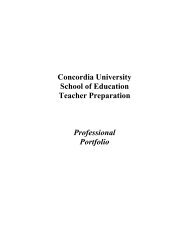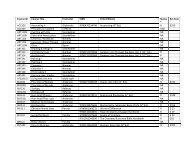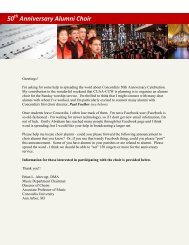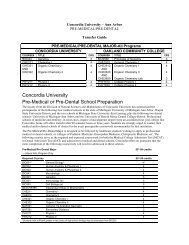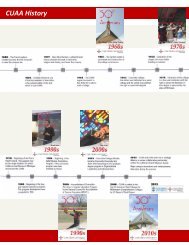2009â2010 Academic Catalog - Concordia University Ann Arbor
2009â2010 Academic Catalog - Concordia University Ann Arbor
2009â2010 Academic Catalog - Concordia University Ann Arbor
You also want an ePaper? Increase the reach of your titles
YUMPU automatically turns print PDFs into web optimized ePapers that Google loves.
<strong>Concordia</strong> <strong>University</strong> <strong>Ann</strong> <strong>Arbor</strong> 2009–2010 <strong>Academic</strong> <strong>Catalog</strong><br />
Maximum Loan Amounts<br />
Undergraduate students<br />
Subsidized Stafford amount $23,000<br />
Combined Subsidized and Unsubsidized Stafford $46,000<br />
Federal Subsidized Stafford Loan<br />
A subsidized loan is a low-interest federal loan for students awarded on the basis of financial need. Loans are<br />
borrowed funds and must be repaid to your lender. The federal government pays the interest while you are<br />
enrolled at least half time (at least six credit hours per semester). Repayment beings six months after you<br />
graduate, withdraw, or drop below half time. The interest rate is variable. Interest rates on Stafford Loans are set<br />
every year by the federal government on July 1st. Standard repayment periods do not exceed 10 years, but<br />
alternative repayment plans are available.<br />
Federal Unsubsidized Stafford Loan<br />
An unsubsidized loan is identical to the subsidized loan except that the student is responsible for the interest<br />
while in school. The student has the option of paying the interest while in school or deferring payment until after<br />
school. If the student opts to defer payment, the interest will be capitalized at repayment.<br />
Other Policies and Procedures<br />
Outside Scholarships<br />
Scholarships from external sources (tuition reimbursement from employer, congregations, foundations, etc.) will<br />
first be used to meet any unmet need in a student’s aid award. If the entire student’s need has been met, the<br />
outside scholarship will then reduce the amount of Stafford loan in the aid award. Under federal guidelines,<br />
scholarships cannot be used to replace the federally determined Expected Family Contribution (EFC) from the<br />
FAFSA if the student is receiving any federal need-based aid in his or her award.<br />
Disbursing Aid to Student Accounts<br />
Federal and state aid is disbursed to students’ account for each term (fall and spring) depending on the start date<br />
of the term. ADP and Graduate students have their semesters start at various times throughout the year. The<br />
Financial Aid Office will use the census to verify enrollment and will then allow the release of funds to the<br />
Business Office to post to individual students accounts. It is up to the student to make sure all loan applications<br />
are completed, and any other paperwork is done in order to finalize the aid award. First-time, first-term students<br />
will not have loan funds released to their accounts until 30 days into the term, according to federal regulations.<br />
We typically have two disbursements per semester. The first disbursement is within the first month of the loan<br />
period. The second disbursement is the later of: the calendar midpoint between the first and last day of class of<br />
the semester or the date the student completes half of the credit hours of the semester. The loan is disbursed in<br />
two equal disbursements.<br />
Refund of Financial Aid<br />
Federal policies require institutions to refund aid to the federal programs according to very specific rules and<br />
regulations. If you withdraw from the university before 60% of the semester has been completed, you may be<br />
required to repay a portion of the financial aid funds awarded to you. In essence, the amount of aid you may keep<br />
is in direct proportion to the length of time you remained enrolled during the semester. The refund formula<br />
measures the actual number of days a student is enrolled during the term, calculates the percentage of the term<br />
the student is enrolled, and uses this percentage to determine how much of the student’s awarded federal aid has<br />
been “earned” by the student for the time he/she was enrolled. This amount can be kept and applied against<br />
incurred charges. If you complete over 60% of the semester you may keep 100% of the aid you received. The<br />
remaining amount to be returned must be returned to the federal aid programs in this order: Unsubsidized Federal<br />
Stafford Loan, Subsidized Federal Stafford Loan, and Federal Pell Grant.<br />
When a student withdraws from school or drops credits during the institution’s refund period, the Michigan<br />
Tuition Grant may need to be reduced. The student’s award will be reduced based on the percent of the tuition<br />
and fees originally paid by MTG and it is governed by state formula.<br />
Special Circumstances<br />
Periodically, students and their families may run into special circumstances that they believe affect their ability to<br />
contribute toward college costs. For instance, if the family has experienced a loss of income from work, or has<br />
unusually high medical expenses that are not covered by insurance. If the family believes that unusual<br />
circumstances exist that need to be taken into consideration in determining their ability to pay, they should<br />
request a “Special Circumstances Form” from the Financial Aid Office.<br />
Pg. 88 of 118




